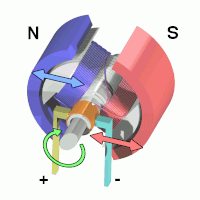
Photo from wikipedia
Abstract In this paper, the double arc interaction mechanism is investigated and the double arc offset is quantitatively analyzed in the high-power double-wire double pulsed gas metal arc welding (DP-GMAW).… Click to show full abstract
Abstract In this paper, the double arc interaction mechanism is investigated and the double arc offset is quantitatively analyzed in the high-power double-wire double pulsed gas metal arc welding (DP-GMAW). Arc offsets in the synchronous and alternating phases were captured using high-speed photography and corresponding voltage and current waveforms were simultaneously recorded during the welding process. Experimental results show the arc offset behavior is affected by the electromagnetic field, arc pressure, and arc stiffness. In the alternating phase, offset of the base arc is largest and offset of the peak arc is smallest. In the synchronous phase, the base and peak arc offsets are somewhere between those in the alternating phase. Dimensional analysis method was used to analyze the factors influencing arc stiffness and in addition, the effects of arc stiffness on arc offset were examined. Increasing the arc stiffness can prevent arc offset, by reducing measurement and experimental errors. Furthermore, the arc stiffness effects were found to be more prominent during the strong pulse compared with the weak pulse, and the arc offsets were smaller in the strong pulse. In the alternating phase, the base arc promotes the formation of molten metal deposits, resulting in the appearance of more prominent fish scales compared with the synchronous phase. Marangoni convection in the weld pool becomes stronger as the phase difference between the two arcs decreases. Moreover, the weld width increases, weld penetration becomes shallower and the weld reinforcement will be lower.
Journal Title: Journal of Manufacturing Processes
Year Published: 2020
Link to full text (if available)
Share on Social Media: Sign Up to like & get
recommendations!